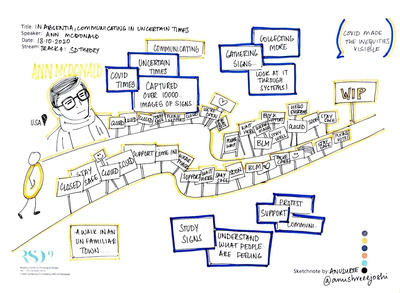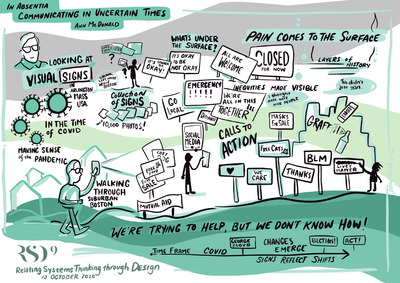In Absentia, Communicating In Uncertain Times: Open, closed, and the space in between us
McDonald, Ann (2020) In Absentia, Communicating In Uncertain Times: Open, closed, and the space in between us. In: Proceedings of Relating Systems Thinking and Design (RSD9) 2020 Symposium., 9-17 Oct 2020, Ahmedabad, India.
![McDonald_RSD9_2020.png [thumbnail of McDonald_RSD9_2020.png]](https://openresearch.ocadu.ca/3664/1.hassmallThumbnailVersion/McDonald_RSD9_2020.png)  Preview |
Image
McDonald_RSD9_2020.png Available under License Creative Commons Attribution Non-commercial No Derivatives. Download (766kB) | Preview |
![McDonald_Uncertain_RSD9_2020.png [thumbnail of McDonald_Uncertain_RSD9_2020.png]](https://openresearch.ocadu.ca/3664/2.hassmallThumbnailVersion/McDonald_Uncertain_RSD9_2020.png)  Preview |
Image
McDonald_Uncertain_RSD9_2020.png Available under License Creative Commons Attribution Non-commercial No Derivatives. Download (3MB) | Preview |
Abstract
In early Spring 2020, many of the urban, public spaces in the US and around the world had visibly fewer people and proliferation of posted signs. Under COVID-19 quarantines and subsequent relaxing policies, a cacophony of visual signs and markings have been added to our physical environments offering visual dialogues in a time of flux, to guide us in maintaining new etiquette and rules. With populations isolated by distancing rules, messages posted on storefronts, floors, sidewalks, and in the windows of homes allow exchange and community support in absentia. These signs are part of an essential system for organizing social cues and protocols to deal with the aftermath of the current health crisis. They are part of an ad hoc system of communications that has evolved and exposed overlapping jurisdictions of local, state, and national rules. These signs are the visual evidence exposing systems of often invisible supply chains and urban space social norms of exchange that are now problematic and unsustainable under COVIS-19 virus spread conditions.
This ongoing study aims to understand the ways that these physical signs, which will undoubtedly continue to evolve as relaxing rules evolve and economic downturn results in more permanent closures, offer visual evidence of deeper systems of policy, economic and supply chain systems.
Patterns of messages of desperation, optimism, concern, and logistical specifics communicated in ever-changing storefront signs posted as part of societal responses to COVID-19 are examined and coded. These visual, temporary markers represent complex systems of local, state, and federal policies and consumer society and services in tremendous flux. In what ways can a study of exchange patterns in the evolving systems of publicly displayed visual communications, reveal the fragility of a fabric assumed to be the norm and evidence of multiple, often competing, underlying systems supposedly designed to provide for well-being?
Storefront communication systems are typically designed to support flux due to seasons and holidays and often leave no trace of former states. A recent article in the New York Times “‘Dear Customers’: These Are the Emotional Store Signs of a Closed New York” and archives such as the “Due to COVID-19: Documenting the signs of the pandemic” celebrate and allow access to the richness of humanity via the sign artifacts created by many in a crisis state.
The outsize impact COVID-19 and forced closures is currently having on small businesses and institutions, and their ability to connect with their customers and constituents is substantial. We can observe evidence of impact through many measures such as ‘temporarily’ curtailed operations, reduced and age-restricted hours, properly spaced lines, curbside pick-up, and other new practices.
Ubiquitous signs of commerce such as ‘Closed’, ‘due to COVID-19 hours’, and ‘Open for takeout only’ predominate. However, there are often messages of community support and blaming and explanation of specific public officials who forced policy changes and closures. There is also a tone of desperation with restaurant signs changing weekly to pitch ‘now selling wine or groceries’ and ‘support local businesses’ sometimes signed with names and individual owner circumstances. There is a proliferation of signs and markings and temporary barricades that instruct us on new behavior and guide us in distancing patterns and offer new options for service exchanges. Beyond the physical signs, community dialogue continues via social media with business Facebook pages broadcasting specifics. And local message boards such as Next Door app exchanges requesting and offering local tips about how individuals can navigate a constantly evolving system of availability and shortages, initiate barter, and support local businesses.
These ubiquitous and often ad-hoc communications often evocatively portray a business’ or community’s response to changing conditions within the broader world. The ad hoc nature and hand-drawn and impromptu printing suggest a temporary state, but as policies and conditions evolve over mid-2020, how will materiality and language suggest an acceptance of a new normal versus a belief in an ongoing temporary state? Many first-round closure signs are posted as evidence of temporary states, leaving the former signs visible in the hope of returning to prior states.
Long before the recent 2020 COVID-19 quarantines, many local storefront businesses had been replaced by online order and delivery services. However, individual and small group connections to local farmer cooperatives, farmer’s markets, and pop-up stores exist as alternate forms of distribution. Many US municipalities are far from policies that support a circular economy, and the ‘costs’ of convenience and access to goods are not readily evident. This moment of crisis and the artifacts that represent change have the potential to reveal.
Methodologies for system analysis are still underway and will evolve, given the current timeliness of this work. At a glance, we can observe and analyze messages through various lenses:
hand-written, drawn, painted, chalked or soap crayoned
individually authored and computer printed
procured from a secondary vendor source
Communication intent and observed patterns:
apologize for closure
clarify hour changes and offer specific reopen dates
empathize and express concern for customers
express solidarity with the local community and overall togetherness
express humor via collective conditions
blame officials for limitations and restrictions
amend plans by leaving a trace of past plans
express uncertainty via open-ended statements about next steps
outline rules of behavior on hygiene, entry, and pick-up services
outline services that involve sequences with mobile phone triggers
project plans for future events that foretell of painful choices
offer virtual versions of service and social media initiatives
relay personal sagas and offer personal contacts and signed messages
show informality via numerous spelling and grammatical errors
However, a thorough analysis also requires a sustained observation of patterns of recorded message sequences over time as quarantine and other policy responses evolve. Businesses have struggled with how to respond and to communicate what is possible now and into the future, with many businesses eventually reopening, reorganizing, and likely failing, the ongoing messaging channels in the physical realm will continue to evolve. A representative sampling of these evolving messages will be archived and presented relationally to evolving policy systems.
| Item Type: | Conference/Workshop Item (Paper) |
|---|---|
| Divisions: | Faculty of Design |
| Date Deposited: | 09 May 2022 15:24 |
| Last Modified: | 09 May 2022 15:24 |
| URI: | https://openresearch.ocadu.ca/id/eprint/3664 |
Actions (login required)
 |
Edit View |

 Tools
Tools Tools
Tools